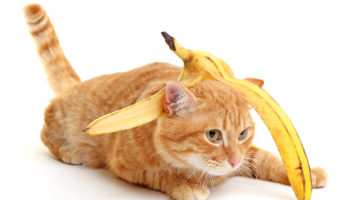Your fridge and pantry contain lots of cat treats… and we’re not talking about the store-bought ones! Here’s some human foods you can share with your kitty.
Thanks to a growing number of natural nutritious cat treats on the market, there’s lots to choose from when you want to give your feline friend something special. But you can broaden the choices even more by giving your cat whole foods from your own kitchen. Let’s take a look at what’s healthy and safe – and what’s not – when it comes to serving your own cat treats.
Meats for treats
Cats are obligate carnivores, which means they need meat in order to stay healthy. Your cat should already be eating a high quality whole meat-based diet, but when it’s time for a treat, you can supplement that diet with some extra meaty tidbits from your own fridge or freezer. Here are some tips to keep in mind when deciding what to give him.
Small pieces of cooked chicken, turkey, beef, venison or fish make excellent cat treats. Be sure to trim the fat from meat or poultry, and make absolutely sure it’s free of cooked bones; they’re sharp and splinter easily.
Raw meat and poultry tidbits are another alternative, although some people may prefer not to use raw meat for treats due to the hand-washing and cleanup required after handling it. Again, trim away excess fat.
Small raw bones are another great cat treat, but it’s important to give your kitty the right kind. The soft bones from a tin of salmon are a good choice. Raw chicken necks are another option, and some people also give their cats raw chicken wings. These not only make delectable treats for most cats, but they also help keep their teeth and gums in good health. It’s a good idea to supervise your cat when he’s eating necks and wings.
A bit of tinned fish makes a good treat as long as it’s packed in water and doesn’t contain additives – look for products that are free of added salt.
Other treat ideas
Meat, fish and poultry aren’t the only treats you can give your cat. Most felines love cheese, for example. Just don’t go overboard with it, since some cats react with diarrhea to dairy products. However, a small morsel of cheddar or a spoonful of cottage cheese make a tasty occasional treat for your feline friend.
Hard-boiled eggs are another source of protein that make a nice cat treat now and then. Cool the egg, and mash or cut it up as if you were going to make egg salad. Just don’t add any extra ingredients. Plain egg is best for your cat. If you wish, you can just give your cat the yolk.
Unlike dogs, many cats turn up their noses at vegetables and fruit – although others don’t. Cats that are raised from kittens to eat a variety of foods will often enjoy a piece of banana, watermelon or cantaloupe, or a cooked baby carrot, green bean or broccoli floret.
Healthy whole-food treats from your own kitchen add variety and flavor to your cat’s diet, while giving him a boost of extra nutrition!
Treat ideas that aren’t good for kitties
Keep in mind that the things we typically consider treats – such as candy, potato chips and baked goods – are a no-no for your cat. They’re too high in carbs, fat, sugar and salt.
Do not give your cat processed meats such as hot dogs, deli meats or tinned meats. These products contain preservatives, such as sodium nitrate, that are not good for your cat, and they’re also usually loaded with salt.
Avoid grapes and raisins, as well as onions and chocolate. Although the jury is still out on whether these foods are as toxic to cats as they are to dogs, it’s best to err on the side of caution and not give them to your kitty.
Don’t give your cat foods like crackers or bits of bread. They’re high in carbs and can lead to weight gain.
Don’t overdo the treats!
Remember that treats are just that – treats. They shouldn’t be provided on a continual basis, nor should be they used to replace your cat’s regular meals. As with people, too many treats can cause weight gain, especially among indoor cats that lead more sedentary lives.
Treats are best used as rewards when your cat does something that pleases you (e.g. uses his scratching post instead of your sofa). Alternatively, set aside one time during the day to give your cat a treat – it could be first thing in the morning, just before bed, or halfway through the afternoon. The key words are “one time” – don’t be giving your cat treats every few hours, no matter how irresistible he is!






No Comment